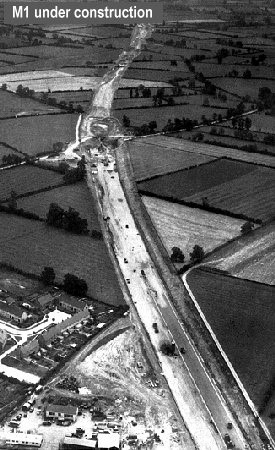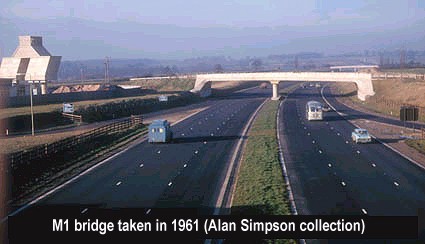
At Beechtrees the MI joins the M10, also a dual two-lane carriageway, which runs for a short distance southeast to join the A5 at Park Street. These lengths of M 1 and M 10 constitute the St Albans by-pass and were designed for the Ministry of Transport by the Hertfordshire County Council.
NOTE: Because of the importance of this, the first inter-urban motorway to be constructed in the UK, an additional page is provided which gives greater insight into the design and construction of this first section of the M1.
Berrygrove to Crick
The first stage to be built was that between Berrygrove and Crick. The London-Birmingham motorway was given priority because of the "immediate and very substantial relief which it could give to the two heavily overloaded trunk roads A5 and A6". The 74 miles of the London - Birmingham motorway to Crick constituted the "first full-scale motorway to be constructed" in the UK and was in fact the southern part of the London-Yorkshire motorway, the M1.

M1 under construction
The southern section from Berrygrove where the M1 joins the A41 to Beechtrees was built with a dual two-lane carriageway and by 1980 congestion at peak times on this section was severe. At Beechtrees the MI joins the M10, also a dual two-lane carriageway, which runs for a short distance southeast to join the A5 at Park Street. These lengths of M 1 and M 10 constitute the St Albans by-pass and were designed for the Ministry of Transport by the Hertfordshire County Council. The carriageways were of 11 in thick but in reinforced concrete on a sub-base normally 7 in thick and were the first motorways to be built with concrete surfaces. Because of heavy rain during construction problems arose with a hoggin sub-base where it was used by construction traffic soon after laying.
North of Beechtrees to Pepperstock, the motorway was also designed for the Ministry by Hertfordshire County Council and was also of concrete construction, but the carriageway was dual three-lane as is the rest of the motorway. From Pepperstock north to Crick, design was carried out by consulting engineers Sir Owen Williams and Partners. These consultants had been commissioned in 1951 by the Ministry of Transport to carry out studies of a route for the London to Yorkshire motorway between St Albans and Doncaster, and in 1955 they were appointed to prepare a scheme for the length from Pepperstock to Crick with a short spur, the M45 connecting the M1 to the Dunchurch by-pass. The scheme was published in September 1955 and confirmed in 1956. Originally it was planned to provide dual two-lane carriageways but this was changed before the scheme was published to dual three-lane. This increased the overall cost by 20% and the land used by 10%, but was estimated to add at least 50% extra traffic capacity to the road.
The Ministry asked if construction could be completed in 19 months, i.e. in two summers instead of the three originally considered, and tenders were sought with these alternative periods of completion on a fixed price basis. The 55 mile length of route was divided into four sections for which tenders were sought and in the event John Laing and Son Ltd were successful tenderers for each of the four sections.
As with the St Albans by-pass, the wet summer of 1958 gave rise to construction problems. There was considerable difficulty with earthworks because of the wet and one of the suggestions by the contractors after the work was completes was that where a high rate of progress was called for, provision should be made in the Bill of Quantities for the cost of importing free-draining sub-base material for use when unfavourable weather conditions demanded it.
This section of motorway was constructed with a dry lean concrete base 14 in thick along the whole length over a 6 in thick sub-base. Hot rolled asphalt was used for both base course (2½ in) and wearing course (1½ in). Shoulders were 8 ft wide and of grass initially, but these were clearly inadequate both in width and strength and one half were changed to be of a stone-based surface treated type.
M1 bridge 1961

M1 bridge taken in 1961
Bridges over the motorway were to a standard design and although they provoked some criticism of their appearance, perhaps because of the relatively 'heavy’ design from using reinforced concrete, this died down with time. Standardisation was important in enabling the contract to be completed within the tight time limits set up.
The motorway was opened informally by Rt Hon Ernest Marples, recently appointed as Minister of Transport. The short ceremony took place near Slip End, at junction 10 south of Luton. It has been recounted that when traffic waiting at the junction to be among the first to travel on the M1 hurtled down the slip road, the normally ebullient Minister exclaimed "My God, what have I started!" What is known for certain from the film clips of the opening in the Laing archive is that he was deeply concerned about safety aspects of driver behaviour. Traffic for a few years continued to hurtle along the M1, before the 70 mph speed limit on motorways was introduced in 1965.
The design of the carriageway pavement on the M1, as on the other early motorways, had no precedent to provide evidence of the amount of traffic or the structural durability of the pavement. A study by the Road Research Laboratory and the University of Birmingham estimated that in 1960 the heaviest traffic flow on the M1 would be about 20,000 vehicles per day south of Luton. In the event, traffic flows have been much higher than predicted and the traffic flow in 1997 on this length was about 140,000 vehicles per day. In addition it was found soon after opening that the concrete haunches on the side of the black top carriageways prevented the escape of water that had entered the pavement materials. The combined effect of heavy traffic and water penetration resulted in stripping of the asphalt binder and weakening of the base course beneath. The width of eight feet of the hard shoulders also proved to be inadequate to allow vehicles to draw clear of the carriageway in an emergency and the slender thickness of up to ten inches would not bear the load of goods vehicles. Later the Ministry standard was changed to require construction to be the same as for the main carriageways and for the width to be increased to 10 ft. Problems also occurred on the concrete carriageways in Hertfordshire with spalling of slabs and joints.
A series of strengthening, resurfacing and drainage improvement have been carried out over the years and the hard shoulders strengthened and widened so that they can be used as a running surface for future maintenance works.
Southward extensions
The M1 was extended southwards in 1966 from Junction 5 with the A41 Watford Bypass at Aldenham to Junction 4 at Brockley, Elstree, a distance of 4 miles. This was designed by Hertfordshire County Council with construction by Fitzpatrick to dual three-lane standard.
The 7-mile remaining southern length of M1 to the A406 North Circular Road at Staples Corner, was designed by W S Atkins and Partners. Named the Hendon Urban Motorway, it followed mostly in cutting along the corridor of the St Pancras - Bedford railway thus minimising the effect on the residential areas, with virtually no increase in severance. On the 4 mile length between Junction 4 and Junction 2 at Page Street, north of Hendon, the contractor for advance work on railway bridges was Holland, Hannen and Cubitt, the Brockley Hill Interchange - Cementation and the main and ancillary works Marples Ridgeway. This length was completed in May 1967. The final 3-mile length between Junction 2 and Junction 1 with the A406 was opened in July 1977, with advance works on the Five-ways Interchange (Junction 2) by Cementation, Staples Corner Interchange (Junction 1) by Taylor Woodrow and main works by Costain.
The dual two-lane length of M1 between Junction 7 at Beechtrees and Junction 8 at Aldenham became seriously congested during the 1970's and was widened to dual three-lane in the early 1980's.